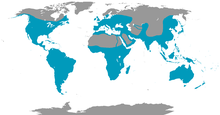Coraciiformes
| Coraciiformes Temporal range:
| |
|---|---|

| |
| European roller Coracias garrulus | |
| Scientific classification | |
| Domain: | Eukaryota |
| Kingdom: | Animalia |
| Phylum: | Chordata |
| Class: | Aves |
| Clade: | Picodynastornithes |
| Order: | Coraciiformes Forbes, 1884 |
| Families | |
For prehistoric taxa, see text. | |

| |
| Global distribution of the kingfisher and allies. | |
The Coraciiformes /kɒrəˈsaɪ.ɪfɔːrmiːz/ are a group of usually colourful birds including the kingfishers, the bee-eaters, the rollers, the motmots, and the todies. They generally have syndactyly, with three forward-pointing toes (and toes 3 & 4 fused at their base), though in many kingfishers one of these is missing.[citation needed] The members of this order are linked by their “slamming” behaviour, thrashing their prey onto surfaces to disarm or incapacitate them.[1]
This is largely an Old World order, with the representation in the New World limited to the dozen or so species of todies and motmots, and a mere handful of the more than a hundred species of kingfishers.
The name Coraciiformes means "
Systematics
| |||||||||||||||||||||||||||||||||
| Phylogenetic relationships between the families based on a large study by Richard Prum and colleagues published in 2015.[3] |
This order has been seen to be something of a mixed assortment, and the Coraciiformes may be considered as including only the rollers. All the other families would then be considered to represent lineages of birds distantly related to Coraciiformes. This seems to be oversplitting, as most Coraciiformes indeed form a reasonably robust clade.
Analysis of
Several extinct coraciiform families are only known from
Taxonomic sequence
Unresolved
- Genus Quasisyndactylus (fossil; Middle Eocene of Messel, Germany) - alcediniform, basal?
- Genus Cryptornis (fossil; Late Eocene of France) – bucerotid? geranopterid?
- Family Primobucconidae (fossil), including Primobucco and Septencoracias
- Coraciiformes gen. et spp. indet. PQ 1216, QU 15640 (fossil; Late Eocene of Quercy, France: Mayr & Mourer-Chauviré 2000)
- Genus Protornis (fossil: Oligocene of Switzerland) – basal to motmotids and meropids?
A recent study suggest that the following families may belong to a separate order called Bucerotiformes. The results still in dispute though.[4]
- Family Bucorvidae(ground hornbills)
- Family Bucerotidae(hornbills)
- Family Upupidae(hoopoe)
- Family Phoeniculidae(woodhoopoes)
The
Basal group
- Family Eocoraciidae (fossil; Middle Eocene of Messel, Germany)
- Family Geranopteridae (fossil; Late Eocene of Quercy, France – Early Miocene of Czech Republic) - includes "Nupharanassa" bohemica
- Family Coraciidae (rollers)
- Family Brachypteraciidae(ground-rollers)
- Family Meropidae(bee-eaters)
Suborder
- Family Todidae(todies)
- Family Momotidae(motmots)
- Family Alcedinidae(kingfishers)
See also
References
- ^ "Coraciiformes". Britannica. Retrieved 13 September 2022.
- ISBN 0-394-46651-9.
- PMID 26444237.
- ^ "Bucerotiformes". tolweb.org. Retrieved 31 March 2018.
- Johansson, Ulf S. & Ericson, Per G. P. (2003): Molecular support for a sister group relationship between Pici and Galbulae (Piciformes sensu Wetmore 1960).
- Mayr, Gerald & Mourer-Chauviré, Cécile (2000): Rollers (Aves: Coraciiformes. s.s.) from the Middle Eocene of Messel (Germany) and the Upper Eocene of the Quercy (France). DOI:10.1671/0272-4634(2000)020[0533:RACSSF]2.0.CO;2 PDF fulltext
- Terres, John K. (1980) The Audubon Society Encyclopedia of North American Birds. ISBN 0-394-46651-9
